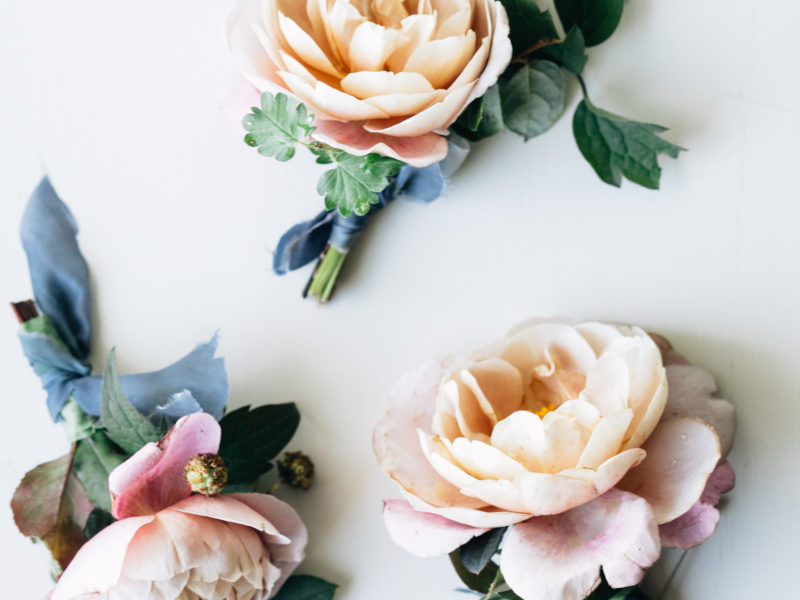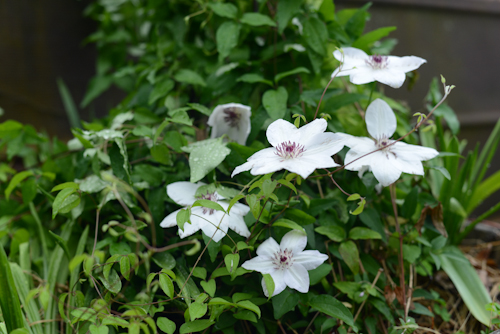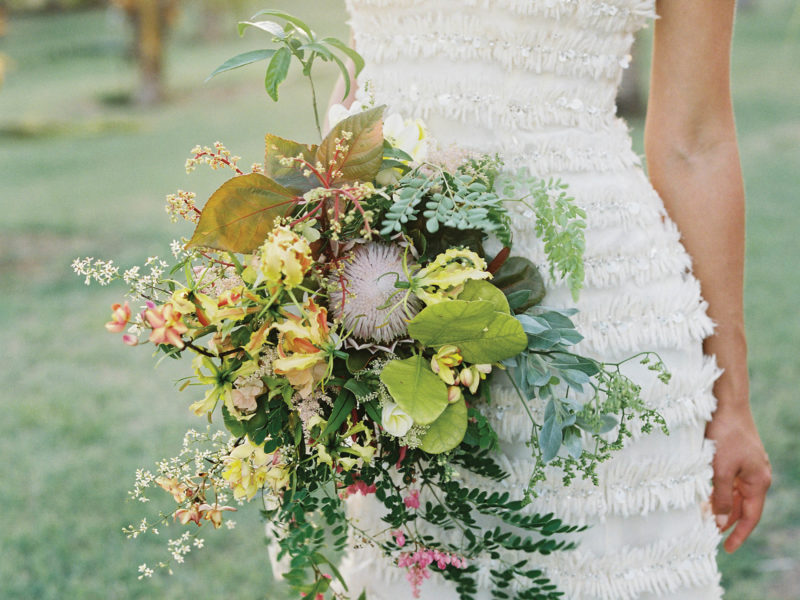Permaculture as Gardening Know-How:
5 Key Takeaways to Start a Garden Bed Using Design Principles of Permaculture
To open a book on permaculture and begin reading without much background knowledge, there’s a chance of feeling lost by the end of the introduction. This was my experience with permaculture when I began working for Nature Composed this past November. I ran into big, lofty concepts like integrated water resources management, ecological engineering, and sustainable architecture. These felt more like roadblocks than doorways to understanding this whole-systems approach. Suffice it to say, I returned the library book without finishing it and feeling fully intimidated.
But working for Jenn Pineau—floral designer, gardener, and owner of Nature Composed—has taught me much more about this holistic approach around land, gardening, farming, and how we, humans, fit into it. And if you attended Jenn’s workshop on permaculture on April 2nd, you also learned some of its core ideas in an easily accessible way and how they can be applied in starting a garden or flower bed. If you missed it (or would like a refresher), read on for some key takeaways to start growing the permaculture way!
Takeaway 1: Read the Room (or Landscape)
As inspiring and helpful as it can be to read up on gardening, composting, or just repotting a houseplant in books or online, we get a much stronger understanding by getting outdoors and our hands dirty. To plan a garden bed that will produce the most bountiful harvest, Jenn advises taking the time to flex our observation muscles.
As humans, we are wired as pattern-finders and toolmakers. By zooming out our perspective to the whole backyard or field where our garden will grow, we’ll learn how sunlight and rain moves across the landscape. We may even pick up on where wildlife might pass through. Piecing together these observations and patterns, we’ll gain a deeper understanding of the ecosystem that our gardens will become a part of, and tools that will best serve us, the garden, and the ecosystem as a whole.
Jenn offers her two properties as examples. Nature Composed is located centrally in town where deer don’t typically pose a threat to any flowers or vegetables. It’s also prone to water pooling when there’s a heavy rain. Meanwhile, her garden beds in Rochelle, VA (about an hour and a half south of Middleburg) are situated on a sloping hill. These zoomed-out observations inform her decisions on what to plant where and when, as well as what potential issues she can prepare for. This is big-picture-thinking, and it is a tenet of permaculture: a keen eye to the natural world and a deep understanding that the whole is greater than the sum of its parts. The clearer that we see nature’s processes, the more innovative we can be in speeding up, amplifying, and reinforcing those processes.
Not only that, but it reminds us that we are working as part of an ecosystem, not outside of it.
Takeaway 2: Progress over Perfection
Using permaculture to guide our gardening not only strengthens our observational skills but also our adaptability. It’s easy to see a photo of a lush or manicured garden, want to recreate it, and quickly feel disheartened when it doesn’t meet our initial vision. Rather than give up, rethink gardening as a practice instead of reaching some optimized, productive space right out of the (garden) gate. Also, reconsider what a “problem” or “failure” is in the garden. Step back from the all-or-nothing attitude and we’ll be open to accept feedback from the environment.
Bill Mollison, one of the pioneering voices in permaculture, puts this idea succinctly: “You don’t have a snail problem, you have a duck deficiency.”
This idea makes me think of an exchange, a conversation, with our surroundings. Plant a favorite variety of tomato plants in an area that always floods, and the environment will tell us it’s not working. Plant ferns where they receive morning sun and afternoon shade, and their thriving is feedback on their placement. Nature asks us to listen, and then to play to our strengths as creative innovators.
Adjusting to a more nuanced approach also means avoiding total eradication. Just as the workshop began, we were stunned by the soft squealing of baby bunnies fleeing a mound of straw that we had disturbed. A mother cottontail had chosen the straw pile for her home, just a few paces from the garden bed Jenn had begun to build. Rather than resort to harsh methods of removing the rabbits, we’ll find ways to work around them.
The same goes for pesky weeds or aggressive-growing plants like a trumpet vine that had sprawled the southern edge of the garden. Applying a chemical that would kill the trumpet vine might also kill the neighboring plants that we’re trying to cultivate or steal vital nutrients from the soil. *Jenn planted other things that could compete better against the trumpet vine, while layering cardboard and straw to help nourish soil and make it easier to weed out the vine’s roots*
Carry on this conversation with the elements from season to season, and we begin to find that our adaptability grows with our gardens, making slow and small solutions with every exchange. Before we know it, we’ll have a garden healthier and more vibrant than anything we could have found in a picture.
Takeaway 3: Mind the Gap (and Edge)
Another permaculture tenet, or design principle, is the edge effect. According to Deep Green Permaculture, “the edge effect is an ecological concept that describes how there is a greater diversity of life in the region where the edges of two adjacent ecosystems overlap, such as land/water or forest/grassland” (Eliades, n.d.). In other words: there tends to be richer life and more biological activity along the edge of two environments.
If we walked out into a wooded area by a stream during this early spring, we’d see this edge effect first-hand. The forest may still be comprised of the wintry grays and browns, but along a gurgling stream, we’d see the fresh shades of green spring up, like moss or the low-lying spring beauty wildflowers. Crouching down to our hands and knees, we may even see evidence of insect or wildlife along the water’s edge, too.
Jenn demonstrated this at the workshop when she first plunged the shovel into the soil, forming the outline of the future flower bed. This outline will be deep enough to collect water, creating an irrigation channel for the flower bed and opening a place where nutrients, helpful insects like worms, and other organisms come together to create “energy traps” and biodiverse perimeters that our new plantings can benefit from (Eliades, n.d.).
The edge effect also connects back to our first takeaway of using our observation skills. As you begin to understand the landscape, consider how the edges of the yard might provide opportunities for catching water, the nutrient-enriching powers of worms, or other hidden benefits.
Takeaway 4: Find your Inner-Gardening-MacGyver
Whether it’s a pesky deer munching on your plants or a surprise frost, there are plenty of constraints to work around when gardening. Time and expense are among those constraints. Jenn advises to do the best we can with what we have. This resourcefulness can save us precious time, hard-earned money, and frustration.
We can’t count on our Virginia spring to be consistent, so seize the gardening day whenever possible. Have an unseasonably warm day in February? Grab a spade and get outside to start carving out a flower bed’s edges. A stretch of frosty weather over spring break? Use the time to start seeds indoors or sketch out the ideal garden space with a cup of tea.
Having a fertile garden doesn’t mean having to break the bank, either. Instead of shelling out for a large, loud tractor and tiller, Jenn recommends the Broadfork tool. It’s a gentler way of aerating the soil for the garden (as well as a satisfying workout!). Instead of buying top-rated mulch or equipment, you may find something in the basement or garage that works just as well that saves money (and a trip to the store).
As most businesses, Nature Composed accumulates its fair share of cardboard boxes from shipments. After unpacking a shipment, the cardboard lives on, flattened and stripped of tape and labels. Just as visitors arrived for the workshop, Jenn had these old boxes soaking in a mix of water and chicken manure that would cover the newly aerated soil. Layering the cardboard with straw works as part of an enriching mulch for a flower bed that keeps weeds from sprouting up. So, the next time an Amazon package arrives in the mail, consider how the box might be repurposed for the garden.
Gardening Trivia: In case you were wondering (as I was at the start of the workshop), there is a difference between straw and hay. Hay is a tall field grass that’s grown to feed animals. Straw is a “by-product […] with hollow stems that makes for a good insulating material” (“What’s the Difference,” n.d.). It’s often used as a bedding for those hay-eating animals but also serves as mulch for a garden as the grain-bearing seed head has already been harvested.
Takeaway 5: Permaculture Patience is a Virtue
This zooming out that permaculture (and nature) requires of the gardener, can feel daunting by all the moving pieces and while navigating the unpredictability that the elements can blow our way. After all, our lives are complex and fast-moving as it is. Not having enough hours in the day is a sentiment many of us have likely shared. And while we’re eager to see the results of our hard work, gardening can be an opportune time to slow down. The compost nest outside the shop sets this example.
After each day of tending to the plants outside and designing floral arrangements inside, we dump heaps of leaves, stems, and dead blooms into the compost nest. It seems hard to believe that anything would happen to them just sitting there. But as everyone at the workshop gathered around, Jenn pulled back the top layers of old plant debris to reveal the dark, rich organic matter underneath. This is the magic that works when allowing things to germinate, grow, bloom, and ultimately break down at their own pace. As we venture out in our own gardens, imagine the magic we might discover by adopting this pace, too!
. . .
It seems strange to consider the shop, Nature Composed, as an ecosystem, but through the lens of permaculture—keen observation, adaptability, progress over perfection, resourcefulness, and patience—all those moving pieces come into focus.
The sun and rains roll over our corner of Pendleton and Federal. Delivery trucks bring us shipments of flowers and plants. Boxes wilt in wheelbarrows of water and manure. We lean into the Broadfork, as soil aerates and churns and transforms. A family of rabbits burrow within it. New growth springs up. Spent growth returns to the breaking down of organic matter. As if choreographed, nature can effortlessly teach us the intuitive ebb and flow of life.
And these ideas around permaculture aren’t limited to gardening or ecological processes. These ideas can work as a kind of philosophy that we might cultivate in other parts of our lives. These ideas shape the value and integrity of soil, of plant life, but also of our own growth in our surroundings. They can guide us on how we approach life, how we contribute to the ecosystem or community, and our own sense of self.
Thanks to everyone who joined the Permaculture workshop and for reading! If you’d like to come to future workshops, hear about other events and goings-on at Nature Composed, sign up for our newsletter and follow along.
[newsletter sign up; social media links]
Sources & References:
Eliades, A. (n.d.). Permaculture design principle 10 – edge effect. Deep Green Permaculture. Retrieved on Sunday April 10, 2022. https://deepgreenpermaculture.com/permaculture/permaculture-design-principles/10-edge-effect/#:~:text=The%20edge%20effect%20is%20an,water%2C%20or%20forest%2Fgrassland.
What’s the difference between hay and straw? (n.d.). Homestead Gardens. Retrieved on April 10, 2020. https://blog.homesteadgardens.com/whats-the-difference-between-hay-and-straw



Share